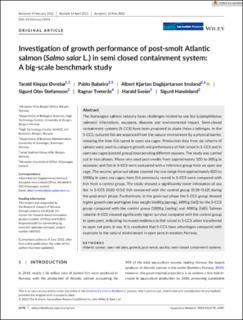| dc.contributor.author | Øvrebø, Tarald Kleppa | |
| dc.contributor.author | Vigo, Pablo Balseiro | |
| dc.contributor.author | Imsland, Albert | |
| dc.contributor.author | Stefansson, Sigurd Olav | |
| dc.contributor.author | Tveterås, Ragnar | |
| dc.contributor.author | Sveier, Harald | |
| dc.contributor.author | Handeland, Sigurd Olav | |
| dc.date.accessioned | 2022-09-12T12:03:02Z | |
| dc.date.available | 2022-09-12T12:03:02Z | |
| dc.date.created | 2022-09-01T19:29:29Z | |
| dc.date.issued | 2022 | |
| dc.identifier.issn | 1355-557X | |
| dc.identifier.uri | https://hdl.handle.net/11250/3017262 | |
| dc.description.abstract | The Norwegian salmon industry faces challenges related to sea lice (Lepeophtheirus salmonis) infestations, escapees, diseases and environmental impact. Semi-closed containment systems (S-CCS) have been proposed to abate these challenges. In the S-CCS, cultured fish are separated from the natural environment by a physical barrier, reducing the time fish spend in open sea cages. Production data from six cohorts of salmon were used to compare growth and performance of fish raised in S-CCS and in open sea cages (control group) incorporating different seasons. The study was carried out in two phases. Phase one used post-smolts from approximately 100 to 800 g in seawater, and fish in S-CCS were compared with a reference group from an open sea cage. The second, grow-out phase covered the size range from approximately 800 to 5000 g in open sea cages; here fish previously reared in S-CCS were compared with fish from a control group. The study showed a significantly lower infestation of sea lice in S-CCS (0.02–0.04) fish compared with the control group (0.18–0.62) during the post-smolt phase. Furthermore, in the grow-out phase the S-CCS group showed higher growth rate and higher final weight (4680 g [spring], 4890 g [fall]) for the S-CCS group compared with the control group (3800 g [spring] and 4080 g [fall]). Salmon raised in S-CCS showed significantly higher survival compared with the control group in open pens, indicating increased resilience in fish raised in S-CCS when transferred to open net pens in sea. It is concluded that S-CCS have advantages compared with exposure to the natural environment in open pens in western Norway. | en_US |
| dc.language.iso | eng | en_US |
| dc.publisher | Wiley | en_US |
| dc.rights | Navngivelse 4.0 Internasjonal | * |
| dc.rights.uri | http://creativecommons.org/licenses/by/4.0/deed.no | * |
| dc.title | Investigation of growth performance of post-smolt Atlantic salmon (Salmo salar L.) in semi closed containment system: A big-scale benchmark study | en_US |
| dc.type | Journal article | en_US |
| dc.type | Peer reviewed | en_US |
| dc.description.version | publishedVersion | en_US |
| dc.rights.holder | Copyright 2022 The Authors | en_US |
| cristin.ispublished | true | |
| cristin.fulltext | original | |
| cristin.qualitycode | 1 | |
| dc.identifier.doi | 10.1111/are.15919 | |
| dc.identifier.cristin | 2048084 | |
| dc.source.journal | Aquaculture Research | en_US |
| dc.source.pagenumber | 4178-4189 | en_US |
| dc.identifier.citation | Aquaculture Research. 2022, 53 (11), 4178-4189. | en_US |
| dc.source.volume | 53 | en_US |
| dc.source.issue | 11 | en_US |

